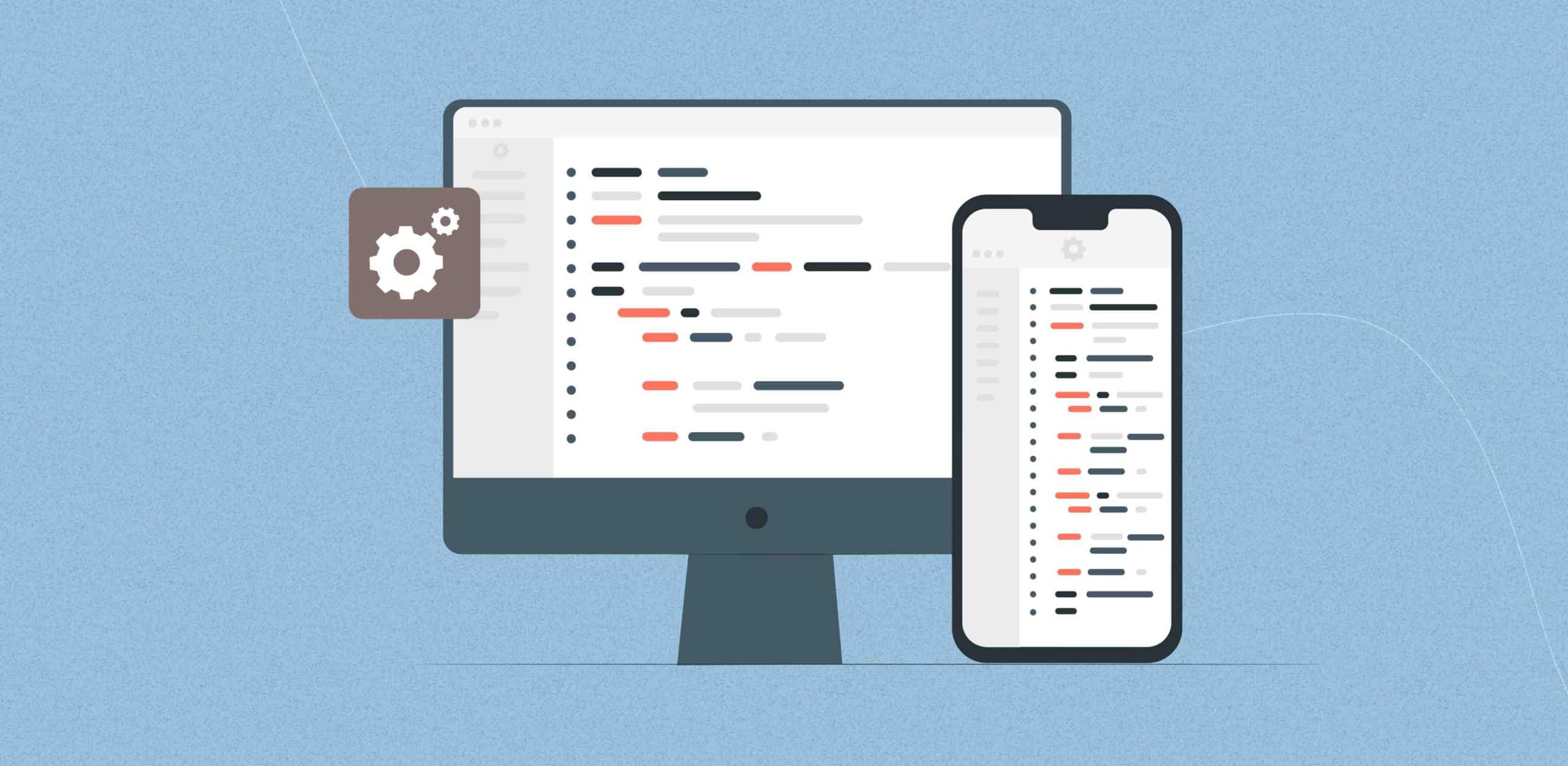WebRTC app development has emerged as the preferred solution for both internal and external business interactions in the ever-evolving landscape of communication technology. Over the past few years, the adoption of WebRTC within the tech community has reached its peak, particularly in the realm of video chat applications. WebRTC plays a pivotal role in establishing enduring business relationships with partners and clients, making it an indispensable tool in today’s corporate world.
WebRTC in detail
WebRTC, or Web Real-Time Communication, is an API-based technology that facilitates peer-to-peer communication between web browsers and mobile applications. It encompasses open-source projects designed for the seamless transmission of audio, video, and data.
WebRTC is often described as both simple and complex. Its simplicity lies in its ease of implementation, requiring just a few lines of code to establish peer-to-peer video communication between browsers. However, its complexity arises from the need to adapt to various browsers and ensure flawless functionality. The beauty of WebRTC lies in its ability to create user-friendly connections without the need for native plugins or app installations. Businesses leverage WebRTC app development to enhance the reliability, speed, and security of their web applications. Moreover, WebRTC’s features are readily available in off-the-shelf solutions, simplifying integration with other software.
Now, let’s explore the intricacies of WebRTC app development to help you choose the ideal solution for your business needs.
How WebRTC Works
WebRTC (Web Real-Time Communication) is a remarkable technology that enables real-time audio and video communication between participants using web browsers. Understanding how WebRTC operates at its core is essential for appreciating its impact on modern communication.
WebRTC’s functionality revolves around its ability to establish direct peer-to-peer connections between browsers. To make this happen, WebRTC employs JavaScript APIs and HTML5. This technology, embraced by major browsers such as Google Chrome, Mozilla Firefox, Safari, and Microsoft Edge, facilitates seamless communication without the need for external plugins or installations. The significance of WebRTC lies in its capacity to leverage the User Datagram Protocol (UDP), a connectionless transport protocol known for its low latency and rapid data transfer. In practical terms, this means that WebRTC can transmit audio and video data in real-time, ensuring that participants can engage in smooth and uninterrupted conversations. This efficiency is paramount, particularly for applications like video conferencing, where even minor delays or packet loss can disrupt the flow of communication.
WebRTC’s internal workings can be simplified into seven fundamental steps that occur between the capture of video from the camera to its display on the screen.
- Initially, the camera captures the video, and the browser’s API grants access to the microphone and camera. However, given the substantial size of uncompressed media streams, data compression becomes a crucial step.
- Codecs, which are algorithms for data compression and decompression, come into play to reduce the size of audio and video streams.
- Real-time Transport Protocol (RTP) packaging is the next step, where data is organized and tagged with information about the order of the packages. This step is crucial because packages may arrive out of sequence or even get lost during transmission.
- Subsequently, the data is transmitted as UDP packages over the network, and the minimal intervals between UDP packages make it ideal for real-time communication. However, UDP has its drawbacks, including the potential for lost or delayed packages.
- Therefore, the next step involves unpacking the RTP data to restore the original order of packages.
- Once the order is reestablished, decoding occurs, resulting in a pure video stream that is ready for display on the screen.
In some instances, you may notice video artifacts, freezing, or pixelation during peer-to-peer communication between two browsers. These issues often stem from package loss due to a lossy network, random loss, or network congestion. Mitigating these challenges is crucial for ensuring stable video communication, and there are several strategies to achieve this. These include network tuning to optimize routes and minimize ping times, adjusting the bitrate by modifying parameters like FPS, quality, and resolution, implementing jitter buffers to request missing packages and reduce freeze times, and using forward error correction to duplicate some data to ensure data integrity. Understanding these steps and challenges is pivotal in harnessing the power of WebRTC for seamless real-time communication.
What are the Advantages and Disadvantages of WebRTC?
Advantages of WebRTC
Implementation Across All Platforms
WebRTC is designed to work seamlessly across various web browsers and platforms. Whether your users prefer Chrome, Firefox, Safari, or Edge, they can enjoy the benefits of WebRTC-powered applications without compatibility concerns.
Utilizes Modern Audio and Video Codecs for High-Quality Communication
WebRTC leverages modern audio and video codecs, ensuring high-quality communication. These codecs are optimized for efficiency and clarity, making them ideal for applications like video conferencing, online gaming, and telehealth services.
Peer-to-Peer (P2P) Communication Ensures End-to-End Encryption
WebRTC facilitates direct peer-to-peer communication between users. This P2P approach not only reduces latency and improves connection quality but also ensures end-to-end encryption. Your data remains secure throughout the entire communication process.
Open-Source and Secure with SRTP and DTLS
WebRTC is an open-source project offering transparency and accessibility for developers. It incorporates robust security measures, including Secure Real-time Transport Protocol (SRTP) and Datagram Transport Layer Security (DTLS). These protocols provide a secure foundation for data transmission, protecting your sensitive information.
Direct Browser-to-Browser Communication
One of WebRTC’s standout features is its ability to establish direct communication between web browsers. Users are not required to install native plugins or third-party applications, simplifying the user experience and promoting widespread adoption.
Built-In Content Capturing Mechanism
WebRTC includes built-in mechanisms for capturing audio and video content directly from user devices. This feature streamlines the development of applications that rely on multimedia input, such as video conferencing, live streaming, and virtual classrooms.
Versatility, Functioning Well on Any OS Supported by WebRTC-Enabled Browsers
WebRTC-based applications exhibit remarkable versatility. As long as the user’s browser supports WebRTC, your application will function smoothly on any operating system. This flexibility extends your application’s reach to diverse devices and platforms, broadening your user base.
Flexible Management Interface Implementation through JavaScript and HTML5
WebRTC offers a flexible management interface that can be implemented using JavaScript and HTML5. This flexibility allows developers to create customized user interfaces tailored to their application’s specific requirements. It empowers you to deliver a user experience that aligns perfectly with your vision.
Disadvantages of WebRTC
High Maintenance Costs
One notable drawback associated with WebRTC app development is the requirement for powerful servers, leading to potentially high maintenance costs. The peer-to-peer architecture of WebRTC, while advantageous for reducing latency and improving security, can demand substantial server resources, particularly in scenarios where a large number of users engage in real-time communication. Maintaining robust servers to support these communication demands may necessitate significant investments in hardware and infrastructure. However, it’s essential to consider these costs within the context of the overall benefits and applications of WebRTC, weighing them against the advantages it offers in terms of real-time, secure, and high-quality communication solutions.
Firewall and NAT Traversal
WebRTC may face difficulties when dealing with firewalls and Network Address Translation (NAT) configurations. In some cases, users may need to adjust their network settings or utilize TURN servers to establish connections, leading to complexity and potential connectivity issues.
Complexity of ICE (Interactive Connectivity Establishment)
ICE, a critical component of WebRTC, can be complex to implement correctly. Handling various network conditions and scenarios requires expertise, potentially leading to development challenges.
Resource Intensive
Real-time communication applications built with WebRTC can be resource-intensive, especially in multi-user scenarios. This may require careful optimization and hardware considerations to maintain smooth performance.
Experience seamless real-time communication with a custom WebRTC app. Connect with our experts to discuss your project requirements.
WebRTC in Business Applications
WebRTC technologies extend beyond video and audio calls, finding applications in various business sectors. Beyond its traditional use, WebRTC is in high demand for telehealth, online education, surveillance, virtual reality gaming, streaming, and the Internet of Things (IoT). Our expert WebRTC developers can tailor solutions to suit diverse business needs.
WebRTC is revolutionizing the healthcare industry by enabling real-time video consultations between patients and healthcare providers. It allows for remote diagnosis, monitoring, and consultation, making healthcare more accessible and convenient.
WebRTC is transforming the way education is delivered. It facilitates live video lectures, virtual classrooms, and one-on-one tutoring sessions. This technology enhances the effectiveness of online learning platforms and fosters better student engagement.
Surveillance and Security
Many businesses use WebRTC for surveillance and security applications. It enables live video streaming from security cameras to any web browser or mobile device, enhancing real-time monitoring and incident response.
Virtual Reality Gaming
WebRTC is making its mark in the gaming industry by enabling multiplayer virtual reality experiences. Gamers can interact with each other in real-time, creating immersive gaming environments that were previously unimaginable.
Live Streaming and Entertainment
WebRTC enhances the quality of live-streaming events, such as concerts, conferences, and sports events. It enables low-latency streaming with high-quality audio and video, providing an engaging experience for viewers.
Internet of Things (IoT)
WebRTC plays a crucial role in IoT applications by enabling real-time communication between IoT devices and users. It allows for remote control, monitoring, and data sharing, enhancing the functionality of smart home devices and industrial IoT solutions.
Customer Support and Sales
Businesses are using WebRTC to offer live customer support through video chat. Customers can connect with support agents in real-time, leading to faster issue resolution and improved customer satisfaction. It is also used in sales for product demonstrations and consultations.
Collaboration and Conferencing
WebRTC powers modern collaboration tools and video conferencing platforms. It enables seamless communication between remote teams, making it easier to conduct virtual meetings, share documents, and collaborate on projects.
E-commerce and Retail
WebRTC enhances the online shopping experience by enabling live video product demonstrations and consultations. Customers can interact with sales representatives, ask questions, and get personalized recommendations.
Financial Services
WebRTC is used in financial institutions for secure video conferencing between advisors and clients. It ensures privacy and compliance with regulations while offering a convenient way to discuss financial matters.
Manufacturing and Remote Assistance
In the manufacturing sector, WebRTC facilitates remote assistance by connecting experts with technicians in the field. It enables real-time troubleshooting and reduces downtime.
Travel and Hospitality
The travel and hospitality industry uses WebRTC for virtual tours, booking assistance, and concierge services. It enhances customer engagement and provides a personalized experience.
What is the Future of WebRTC?
The future of WebRTC shines brightly, underpinned by remarkable growth and promising technological advancements. According to a Market Study Report, the global market size of WebRTC is predicted to surge to a staggering $16,750 million by 2026. This projection signifies a remarkable uptrend attributed to factors such as increased browser support, expanding applications, and rising demand for real-time communication solutions. The influence of WebRTC is spreading across continents, with a significant presence.
As the adoption rate continues to climb, the global business landscape is being reshaped by WebRTC’s capabilities.
One of the driving forces behind WebRTC’s future is its rapid development within the World Wide Web Consortium (W3C). The consortium’s commitment to evolving WebRTC ensures that this technology remains at the forefront of real-time communication solutions. In the pipeline, we anticipate the modernization of codecs like AV1 and VP9, further enhancing the quality of audio and video transmissions. Additionally, the implementation of tools such as noise suppression and background blur in WebRTC-enabled platforms, particularly in Chrome, is set to improve the overall user experience. As the meeting space facilitated by WebRTC continues to expand, it will undoubtedly influence the complexity of solutions, leading to even more versatile and efficient real-time communication applications. The future of WebRTC is a testament to its adaptability and potential to shape the way we communicate across diverse industries and applications.
What are the Key Trends in WebRTC App Development?
Mobile-First Approach
With the growing popularity of smartphones and tablets, WebRTC app developers are focusing on creating mobile-friendly applications.The mobile-first design ensures seamless user experiences across various devices and platforms.
AI Integration
Integration of Artificial Intelligence (AI) and machine learning is becoming increasingly common in WebRTC apps. AI-powered features like speech recognition, language translation, and sentiment analysis enhance user interactions and communication quality.
Low-Latency Streaming
Real-time communication demands minimal latency for a smooth user experience. Developers are optimizing WebRTC apps for low-latency streaming, making them suitable for applications like online gaming and live broadcasting.
Scalability and Reliability
Scalability is crucial for WebRTC apps, especially for those used in large-scale video conferencing or live events. Developers are adopting serverless architectures and load-balancing techniques to ensure reliability and scalability.
WebRTC APIs and Libraries
The WebRTC development community continues to evolve, offering a wide range of APIs and libraries. These resources simplify the development process and enable developers to create feature-rich applications faster.
Enhanced Security Measures
Security is a top priority for WebRTC app developers to protect user data and communication. Implementation of end-to-end encryption and secure authentication methods is on the rise.
Cross-Browser Compatibility
Ensuring compatibility across different web browsers is essential for WebRTC apps’ success. Developers are working to address browser-specific issues and ensure consistent performance.
Multi-Platform Support
Users expect WebRTC apps to work seamlessly on various platforms, including web browsers, mobile apps, and desktop applications. Cross-platform development frameworks are gaining popularity to streamline development efforts.
Augmented Reality (AR) and Virtual Reality (VR)
WebRTC is being integrated into AR and VR applications, enabling real-time communication within immersive experiences. This trend opens up new possibilities for interactive gaming, remote collaboration, and virtual events.
WebRTC in IoT
The Internet of Things (IoT) is another frontier for WebRTC applications.
Developers are leveraging WebRTC to enable real-time communication between IoT devices, enhancing automation and control.
Healthcare and Telemedicine
WebRTC is playing a significant role in the telemedicine industry, facilitating remote doctor-patient consultations and medical diagnostics. Secure and reliable communication is essential in this sector.
Evolving Use Cases
As technology evolves, new use cases for WebRTC continue to emerge.
Developers are exploring applications in areas like smart home automation, education, customer support, and more.
Conclusion
As a leading WebRTC app development company, Enfin is committed to revolutionizing the way you connect with your partners and clients. We offer top-tier WebRTC application development services with skilled WebRTC developers who excel in crafting solutions that bridge the gap between simplicity and complexity. Our expertise ensures smooth peer-to-peer communication through video, audio, and data sharing, whether you aim to enhance internal processes, enable telehealth services, elevate online education, or explore the exciting realms of virtual reality gaming and IoT.
Join us in shaping the future of communication – reach out to us today to discuss implementing or custom-developing a tailored WebRTC solution that perfectly aligns with your business needs. Your seamless, immersive communication journey begins here.
Let’s transform your business for a change that matters.
F. A. Q.
Do you have additional questions?
WebRTC, or Web Real-Time Communication, is an API-based technology that enables peer-to-peer communication among web browsers and mobile applications. It allows real-time audio and video communication between participants, using JavaScript APIs and HTML5. This technology facilitates direct connections, bypassing firewalls and enabling efficient data transmission.
WebRTC has gained popularity in both internal and external business communication due to its ability to provide seamless video and audio calls. It enhances long-lasting business relationships by enabling high-quality communication, end-to-end encryption, and the convenience of open-source solutions. This technology also finds applications in various business sectors beyond traditional communication.
WebRTC offers several advantages for business applications, including its implementations across platforms, modern audio and video codecs for high-quality communication, end-to-end encryption for security, open-source nature, and the flexibility to work on different operating systems as long as the browser supports WebRTC.
A WebRTC development company plays a crucial role in leveraging this technology for business success. They have skilled WebRTC developers who can design and implement solutions for seamless communication, tailored to specific business needs. These solutions can include features like video and audio calls, data transmission, and integration with existing software.
The future of WebRTC looks promising as it continues to evolve. There is ongoing development by organizations like the World Wide Web Consortium (W3C), advancements in codecs like AV1 and VP9, and improvements in tools for noise suppression and background blur. With the growing demand for high-quality communication solutions, WebRTC is expected to have a significant impact across various industries.














